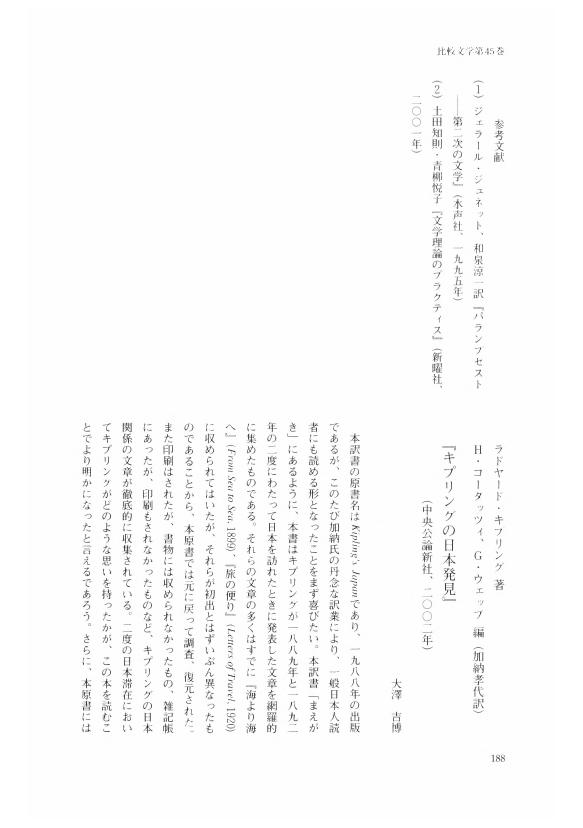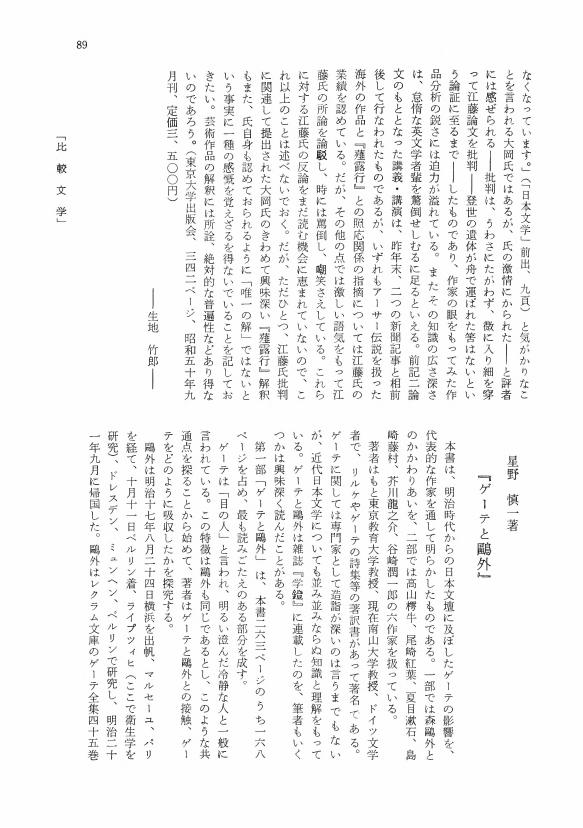- 著者
- 大澤 吉博
- 出版者
- 日本比較文学会
- 雑誌
- 比較文学 (ISSN:04408039)
- 巻号頁・発行日
- vol.45, pp.188-189, 2003-03-31 (Released:2017-06-17)
1 0 0 0 OA 星野 慎一著 『ゲーテと鷗外』
- 著者
- 福田 英男
- 出版者
- 日本比較文学会
- 雑誌
- 比較文学 (ISSN:04408039)
- 巻号頁・発行日
- vol.19, pp.89-90, 1976-12-20 (Released:2017-07-31)
1 0 0 0 小林愛雄の歌劇翻訳
- 著者
- 伊藤 由紀
- 出版者
- 日本比較文学会
- 雑誌
- 比較文学 (ISSN:04408039)
- 巻号頁・発行日
- vol.51, pp.106-120, 2009
<p> In the 1910s in Japan, attempts were made to perform European operas by translating their lyrics into Japanese. One of the leaders of the movement, Kobayashi Aiyû (1881–1945) translated 15 librettos for grand and comic operas during the decade. Although some of the pieces from those works were widely sung in prewar Japan, there have been few studies about Kobayashi's translation.</p><p> In this paper, we will discuss the libretto of Franz von Suppé's comic opera <i>Boccaccio,</i> translated by Kobayashi in 1915 at its Japan premier, to understand how Kobayashi rendered lyrics with meters and rhymes into non-accentual Japanese language.</p><p> Although a song from the work, <i>"Beatori nêchan"</i> ("Holde Schöne, hör diese Töne"), is still known today, we find that the lyrics of the piece in Kobayashi's libretto are more dignified than today's colloquial version.</p><p> Prosodic analysis suggests that Kobayashi used the English translation of the libretto (1880, by Dexter Smith) as a direct source, rather than its original text written in German (1879). Therefore, Kobayashi's lyrics have the same alteration of versification from the German libretto as the English version. Moreover, Kobayashi sometimes seems to have ignored the syllable number required by Suppé's score. Accordingly, his lyrics presented some difficulty in singing so that singers might have to alter the wordings.</p><p> Despite all these problems, Kobayashi was good at songs about love or nostalgia. Therefore, <i>"Koi wa yasashii nobe no hanayo"</i> ("Hab' ich nur deine Liebe") from the same work has been sung in his original lyrics until today.</p>
1 0 0 0 OA 詩と絵画の交響
- 著者
- 金田 由紀子
- 出版者
- 日本比較文学会
- 雑誌
- 比較文学 (ISSN:04408039)
- 巻号頁・発行日
- vol.41, pp.21-35, 1999-03-31 (Released:2017-06-17)
This paper discusses how Frank O’Hara (1926-66) achieved his stylistic innovation in his poetry through his profound knowledge of the paintings of the New York School. Though what actually happened was an interaction between literature and the visual arts, the discussion will mainly focus on the aesthetic significance of the paintings on the formation of O’Hara’s poetics and style. When O’Hara began getting his poems published in Michigan and New York in the early fifties, the New Criticism and academic verse were still exerting a strong influence on American poetry. O’Hara, an art critic as well as a poet, dissatisfied with the stylistic mannerisms of academic verse and blessed with great opportunities to familialize himself with the avant-garde paintings of his time, created his idiosyncratic style by applying the stylistic innovations of the New York School paintings to his poetry. Of O’Hara’ aesthetic responses to the New York School paintings, the most significant is their expressionist aspect, that is, how the artist’s self should be represented in his/her work, because that was the most urgent problem for O’Hara when he began writing poetry. This paper focuses on O’Hara’s expressionist aesthics, and is divided into three parts: its relation to his early art criticism , the second generation painters of the New York School, and early examples of Pop Art. In each part, the discussion will elucidate how O’Hara’s poetics and new style evolved from his aesthetic contact with the art of his day.
- 著者
- 橋本 順光
- 出版者
- 日本比較文学会
- 雑誌
- 比較文学 (ISSN:04408039)
- 巻号頁・発行日
- vol.58, pp.126-128, 2015
1 0 0 0 風雅論としての花札
- 著者
- Schaumann Werner
- 出版者
- 日本比較文学会
- 雑誌
- 比較文学 (ISSN:04408039)
- 巻号頁・発行日
- no.26, pp.p5-18, 1983
1 0 0 0 「禁色」と「ドリアン・グレイの肖像」
- 著者
- 堀江 珠喜
- 出版者
- 日本比較文学会
- 雑誌
- 比較文学 (ISSN:04408039)
- 巻号頁・発行日
- no.27, pp.p5-17, 1984
- 著者
- 藤原 まみ
- 出版者
- 日本比較文学会
- 雑誌
- 比較文学 (ISSN:04408039)
- 巻号頁・発行日
- vol.55, pp.62-75, 2012

